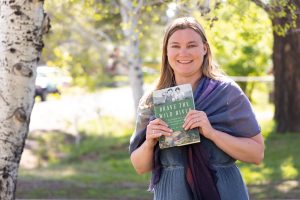I’ve learned it’s hard to “act like a lady” when nature sings to your soul and beckons you to climb on rocks and wade in rivers.
Before McDonald’s had the ball pit, leaves were the things kids would roll around in. Leaves are fun. And that’s what I would try to explain to my after-kindergarten caregivers when they gave me that exasperated look and the sigh that followed while plucking leaves from the lacy designs on my tights again, before my mom came to pick me up.
I’ve learned it’s hard to “act like a lady” when nature sings to your soul and beckons you to climb on rocks and wade in rivers. And that’s why I love author Melissa Sevigny’s new book, “Brave the Wild River: The Untold Story of Two Women Who Mapped the Botany of the Grand Canyon.”
Through her captivating storytelling skills, Sevigny allows us to vicariously dip our toes into the mighty Colorado while immersing us in a time that was really quite limiting for girls and women.
In 1938, Elzada Clover and Lois Jotter were two botanists who seemed to be driven by curiosity and didn’t mind getting messy on their journey to scientific discovery.
Sevigny writes that women of the day were not encouraged to pursue science; however, botany was socially acceptable. “Botany’s virtues were women’s virtues: gentility, innocence and modesty. Flowers, after all, reflected the qualities most treasured in women; fragility, purity and loveliness.”
Interestingly enough, women were mostly the ones who were gathering plant specimens and pressing them for researchers to study. However, as Sevigny explains, “they were not permitted to collect any plant that couldn’t be reached on a leisurely afternoon stroll.”
Of course, what these two women had in mind was no leisurely afternoon stroll. They were called to the Grand Canyon and a river that only 50 men before them had survived.
“With its churning waters and treacherous boulders, the Colorado was famed as the most dangerous river in the world,” wrote Sevigny. “Journalists and veteran river runners boldy proclaimed that the motley crew would never make it out alive. But for Clover and Jotter, no one had yet surveyed the plant life of the Grand Canyon, and they were determined to be the first.”
Because of their efforts, we now have a catalog of thorny, spiny and spiky specimens that lived along the Colorado River more than 70 years ago, a time when humans had just begun to change the river ecosystem.
These women were pioneers, scientists and change-agents in the history of the American West. Their journey was stickery, muddy, rocky and scary at times, but because of their determination and courageous bushwhacking ways, Clover, Jotter and many other women made the path much smoother for generations of women who followed to pursue their own passions, no matter how messy they might be.
This fall, I invite you to frolic to the rhythms of nature, the beat of your heart and the calling of your soul, even if you get leaves in your stockings. QCBN
By Bonnie Stevens
Bonnie Stevens is a public relations consultant. She can be reached at bonnie.stevens@gmail.com.
Hear from Melissa Sevigny on Zonie Living at www.starworldwidenetworks.com.
Courtesy Photo: KNAU science reporter Melissa Sevigny says her new book, Brave the Wild River, took five years to research and write, including a river rafting trip down the Colorado River. It is available now on Amazon.







Leave a Reply